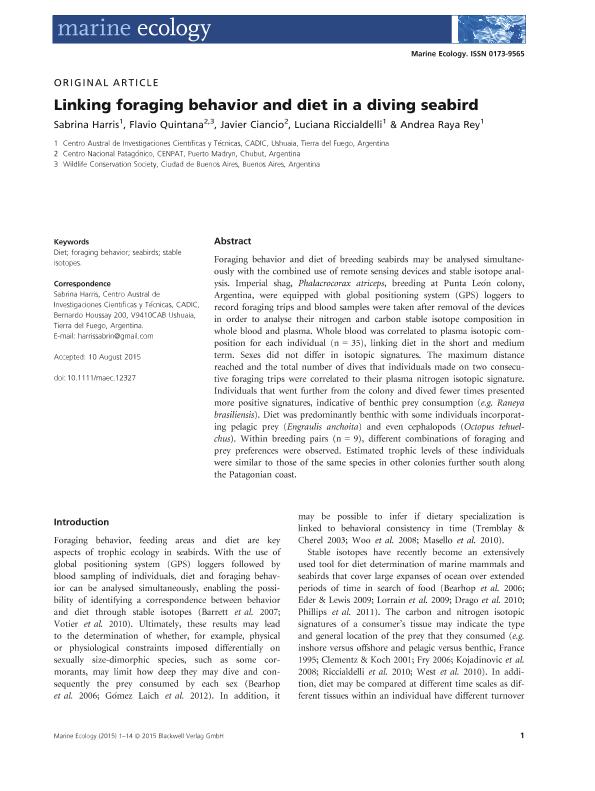Artículo
Linking foraging behavior and diet in a diving seabird
Harris, Sabrina ; Quintana, Flavio Roberto
; Quintana, Flavio Roberto ; Ciancio Blanc, Javier Ernesto
; Ciancio Blanc, Javier Ernesto ; Riccialdelli, Luciana
; Riccialdelli, Luciana ; Raya Rey, Andrea Nélida
; Raya Rey, Andrea Nélida
 ; Quintana, Flavio Roberto
; Quintana, Flavio Roberto ; Ciancio Blanc, Javier Ernesto
; Ciancio Blanc, Javier Ernesto ; Riccialdelli, Luciana
; Riccialdelli, Luciana ; Raya Rey, Andrea Nélida
; Raya Rey, Andrea Nélida
Fecha de publicación:
12/2015
Editorial:
Wiley
Revista:
Marine Ecology
ISSN:
0173-9565
Idioma:
Inglés
Tipo de recurso:
Artículo publicado
Clasificación temática:
Resumen
Foraging behavior and diet of breeding seabirds may be analysed simultaneously with the combined use of remote sensing devices and stable isotope analysis. Imperial shag, Phalacrocorax atriceps, breeding at Punta León colony, Argentina, were equipped with global positioning system (GPS) loggers to record foraging trips and blood samples were taken after removal of the devices in order to analyse their nitrogen and carbon stable isotope composition in whole blood and plasma. Whole blood was correlated to plasma isotopic composition for each individual (n = 35), linking diet in the short and medium term. Sexes did not differ in isotopic signatures. The maximum distance reached and the total number of dives that individuals made on two consecutive foraging trips were correlated to their plasma nitrogen isotopic signature. Individuals that went further from the colony and dived fewer times presented more positive signatures, indicative of benthic prey consumption (e.g. Raneya brasiliensis). Diet was predominantly benthic with some individuals incorporating pelagic prey (Engraulis anchoita) and even cephalopods (Octopus tehuelchus). Within breeding pairs (n = 9), different combinations of foraging and prey preferences were observed. Estimated trophic levels of these individuals were similar to those of the same species in other colonies further south along the Patagonian coast.
Palabras clave:
Diet
,
Foraging Behavior
,
Seabirds
,
Stable Isotopes
Archivos asociados
Licencia
Identificadores
Colecciones
Articulos(CADIC)
Articulos de CENTRO AUSTRAL DE INVESTIGACIONES CIENTIFICAS
Articulos de CENTRO AUSTRAL DE INVESTIGACIONES CIENTIFICAS
Articulos(CCT-CENPAT)
Articulos de CTRO.CIENTIFICO TECNOL.CONICET - CENPAT
Articulos de CTRO.CIENTIFICO TECNOL.CONICET - CENPAT
Articulos(SEDE CENTRAL)
Articulos de SEDE CENTRAL
Articulos de SEDE CENTRAL
Citación
Harris, Sabrina; Quintana, Flavio Roberto; Ciancio Blanc, Javier Ernesto; Riccialdelli, Luciana; Raya Rey, Andrea Nélida; Linking foraging behavior and diet in a diving seabird; Wiley; Marine Ecology; 37; 2; 12-2015; 419–432
Compartir
Altmétricas



